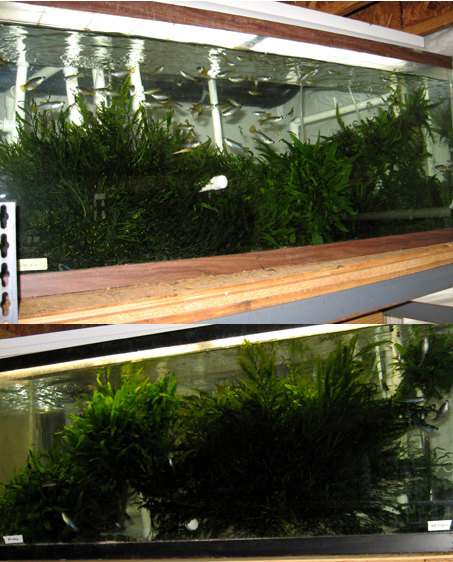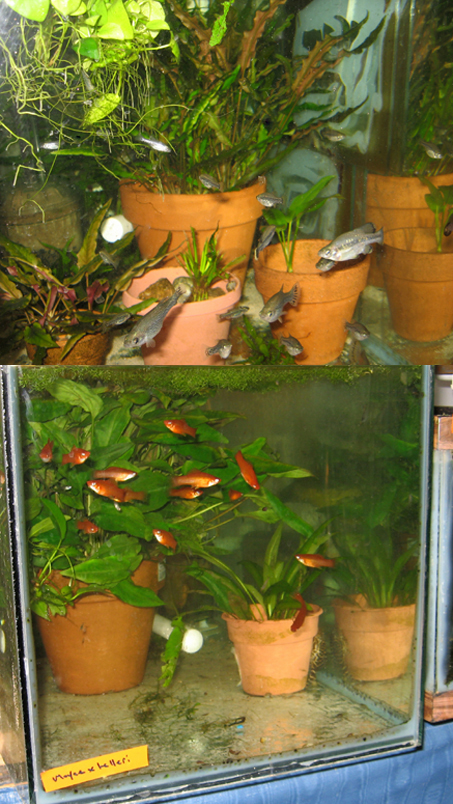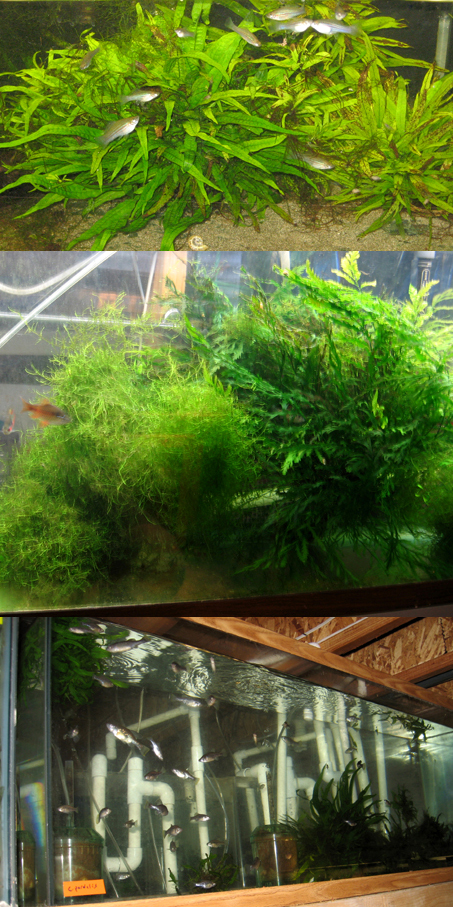|
The top two pics
are two types of plants that
are used for
different reasons. In the top tank of Alfaro
cultratus, the plants
provide shelter for
fry. When looking in, new
fry can be seen
immediately and caught,
removing the plants as necessary.
The left side of the tank
is a single Bolbitis fern, clumps of
Java fern are on the right. The cultratus can be fry
eaters, but
they are fed twice a day, and if caught soon after being born
are generally left alone.
In
the 2nd pic is the 50 gallon high fin mayae
breeder tank,
the females are pulled as they
become gravid, and the adults
prefer
plants to
hide in. The right 2/3rds is a single Bolbitis fern,
Java fern clumps are on the
left.
Of these plants, the only one that
some say they have
trouble keeping was the Bolbitis fern,
yet they thrive and
grow larger than people are used to seeing. I have since
come to learn that they do well with frequent
water changes
being indigenous to
streams and generally moving water
They also require
moderate light. The
Bolbitis fern
also responds well to using
fertilizer, as all plants do.
Potted plants are used
often, and some tanks are used to
start or propagate crypts, Amazon swords
and different types
of Anubias,
as is being done in this tank of Ameca
splendens.
The Cryptcoryne wendtii and various other
plants can be
seen in this photo.
A number of plants
are avoided, because there have not been
good results in the past, but those plants may do routinely well
for
others. I attribute this to the
water quality here and the low
to moderate
light provided. These may be plants
that will do
well for you,
as they are also generally hardy and do well in
most circumstances.
Examples include Elodea / Egeria,
Anacharis sp., any Cabomba,
Hygrophila, Ceratophyllum,
Myriophyllum, Ludwigia, and
Najas grass.
As
well, there are many others that do well that are not being
being kept at this time, such as any Salvinia, and Water lettuce-
Pistia stratiotes.
The
importance of the cleanliness of a bare bottom tank can't
be overstated. In this tank to the left of the Hybrid Red X. helleri,
easy
access to clean up uneaten food or other organic matter
keeps them healthy and
growing at their maximum rate. Rockwork
or driftwood could be added
to create a beautiful display..
Many plants used and sold
in the aquarium trade are actually not
true aquatic
plants, such as the Spathiphyllum, a common
aquarium and houseplant. Many thick-leaved
non-aquatic plants
will
thrive in an aquarium. I believe the potted plant on the left,
sold as an aquatic plant, may be
an example. Floating on the
surface is a layer of Riccia,
also known as Crystalwort.
The best use of
plants is for breeding by providing the type
of
environment where the fish are most comfortable, as with
the
X. mayae high fins above, or in the
regular X. mayae
breeding tank in the first pic with Java ferns to the
left. The
secret is to provide ample hiding room and security while
preventing decaying organic matter to collect. With the
tank to the left, gravid females are pulled to have their
young separately, but fry
occasionally born in this tank
have many places to hide
until I can remove them.
The bottom has a thin layer
of gravel to assist biological
filtration, as organic matter can collect beneath the plant
clumps, requiring that they be lifted occasionally to clean
beneath them.
Likely the most common
plant in most fishrooms is
Java moss,
a very fine leaved plant that is excellent for
sheltering eggs and new fry. The Neocaridina
shrimp
seem to require it (Though they will eat eggs given the
opportunity). In the second pic at left, Java moss
rests
against another Bolbitis fern. Java moss
also catches
any leftover food and waste in the tank, and can become
a
problem if not thinned occasionally, acting exactly as
a
layer of gravel would, holding and
allowing organic
waste to fester unseen.
Unfortunately, you also do not
see fish well when they
hide in it, and you can lose fish
without being aware of it.
In
this adult breeding tank of C. pardalis,
gravid
females are removed to have their young, and the
adults are comfortable swimming out in the open.
Clumps of Java fern are provided for the occasional
young to hide in that are quickly caught and raised in
other tanks, while also providing some sense of
security for the adults.
Home
Contact Us
Receiving Shipped Fish
X
|
 |


